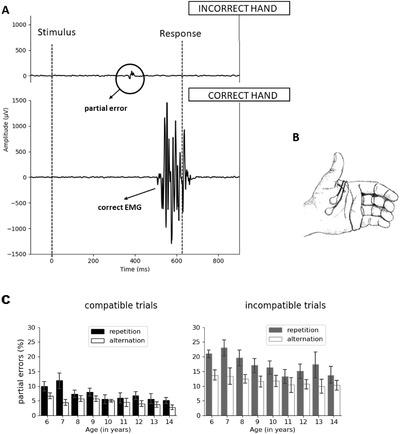Our official English website, www.x-mol.net, welcomes your feedback! (Note: you will need to create a separate account there.)
Developmental changes in impulse control: Trial-by-trial EMG dissociates the evolution of impulse strength from its subsequent suppression
Developmental Science ( IF 4.939 ) Pub Date : 2022-04-25 , DOI: 10.1111/desc.13273 Kamila Śmigasiewicz 1 , Solène Ambrosi 2 , Agnès Blaye 2 , Boris Burle 1
Developmental Science ( IF 4.939 ) Pub Date : 2022-04-25 , DOI: 10.1111/desc.13273 Kamila Śmigasiewicz 1 , Solène Ambrosi 2 , Agnès Blaye 2 , Boris Burle 1
Affiliation

|
Goal-oriented behavior can be disrupted by irrelevant information that automatically activates incorrect responses. While behavioral errors reveal response capture in such situations, they are only the tip of the iceberg. Additional subliminal activations of the incorrect responses (partial errors) can be revealed on correctly responded trials thanks to electromyography (EMG). In the current study, for the first time, EMG recorded in children was combined with distributional analyses. This allowed to investigate the properties of incorrect response activations and to highlight developmental changes in impulse control. A sample of 114 children aged 6–14 years was studied. Children performed a Simon task in which the irrelevant stimulus-position automatically activates a response that might be compatible or incompatible with the correct one. On incompatible trials, the automatic response activation must be overcome by controlled response selection. As previously observed in adults, our approach revealed the presence of an automatic EMG activation of the incorrect response elicited by the irrelevant stimulus dimension. Further, it revealed another independent source at the origin of incorrect response activations: the tendency to guess for response alternation. Both sources increased the frequency of early incorrect EMG activations, indicating impulsive responding. In addition, the influence of both sources decreased with increasing age. Thus, development is marked by improved ability to manage distractibility on the one hand and decreased tendency to rely on a guessing strategy on the other.
中文翻译:

冲动控制的发展变化:通过试验 EMG 将脉冲强度的演变与其随后的抑制分离
以目标为导向的行为可能会被不相关的信息打乱,这些信息会自动激活不正确的反应。虽然行为错误揭示了在这种情况下的反应捕获,但它们只是冰山一角。由于肌电图 (EMG),可以在正确反应的试验中揭示不正确反应(部分错误)的额外潜意识激活。在目前的研究中,首次将儿童肌电图记录与分布分析相结合。这允许调查不正确响应激活的属性并突出冲动控制的发展变化。对 114 名 6-14 岁儿童的样本进行了研究。孩子们执行了一项西蒙任务,其中不相关的刺激位置会自动激活可能与正确的反应相容或不相容的反应。在不兼容的试验中,必须通过受控响应选择来克服自动响应激活。正如之前在成人中观察到的那样,我们的方法揭示了不相关刺激维度引起的不正确反应的自动 EMG 激活的存在。此外,它揭示了不正确反应激活起源的另一个独立来源:猜测反应交替的倾向。这两个来源都增加了早期不正确的 EMG 激活频率,表明冲动反应。此外,这两种来源的影响随着年龄的增长而减弱。因此,发展的标志是一方面提高了管理注意力分散的能力,另一方面降低了依赖猜测策略的倾向。必须通过受控响应选择来克服自动响应激活。正如之前在成人中观察到的那样,我们的方法揭示了不相关刺激维度引起的不正确反应的自动 EMG 激活的存在。此外,它揭示了不正确反应激活起源的另一个独立来源:猜测反应交替的倾向。这两个来源都增加了早期不正确的 EMG 激活频率,表明冲动反应。此外,这两种来源的影响随着年龄的增长而减弱。因此,发展的标志是一方面提高了管理注意力分散的能力,另一方面降低了依赖猜测策略的倾向。必须通过受控响应选择来克服自动响应激活。正如之前在成人中观察到的那样,我们的方法揭示了不相关刺激维度引起的不正确反应的自动 EMG 激活的存在。此外,它揭示了不正确反应激活起源的另一个独立来源:猜测反应交替的倾向。这两个来源都增加了早期不正确的 EMG 激活频率,表明冲动反应。此外,这两种来源的影响随着年龄的增长而减弱。因此,发展的标志是一方面提高了管理注意力分散的能力,另一方面降低了依赖猜测策略的倾向。我们的方法揭示了不相关刺激维度引起的不正确反应的自动 EMG 激活的存在。此外,它揭示了不正确反应激活起源的另一个独立来源:猜测反应交替的倾向。这两个来源都增加了早期不正确的 EMG 激活频率,表明冲动反应。此外,这两种来源的影响随着年龄的增长而减弱。因此,发展的标志是一方面提高了管理注意力分散的能力,另一方面降低了依赖猜测策略的倾向。我们的方法揭示了不相关刺激维度引起的不正确反应的自动 EMG 激活的存在。此外,它揭示了不正确反应激活起源的另一个独立来源:猜测反应交替的倾向。这两个来源都增加了早期不正确的 EMG 激活频率,表明冲动反应。此外,这两种来源的影响随着年龄的增长而减弱。因此,发展的标志是一方面提高了管理注意力分散的能力,另一方面降低了依赖猜测策略的倾向。这两个来源都增加了早期不正确的 EMG 激活频率,表明冲动反应。此外,这两种来源的影响随着年龄的增长而减弱。因此,发展的标志是一方面提高了管理注意力分散的能力,另一方面降低了依赖猜测策略的倾向。这两个来源都增加了早期不正确的 EMG 激活频率,表明冲动反应。此外,这两种来源的影响随着年龄的增长而减弱。因此,发展的标志是一方面提高了管理注意力分散的能力,另一方面降低了依赖猜测策略的倾向。
更新日期:2022-04-25
中文翻译:

冲动控制的发展变化:通过试验 EMG 将脉冲强度的演变与其随后的抑制分离
以目标为导向的行为可能会被不相关的信息打乱,这些信息会自动激活不正确的反应。虽然行为错误揭示了在这种情况下的反应捕获,但它们只是冰山一角。由于肌电图 (EMG),可以在正确反应的试验中揭示不正确反应(部分错误)的额外潜意识激活。在目前的研究中,首次将儿童肌电图记录与分布分析相结合。这允许调查不正确响应激活的属性并突出冲动控制的发展变化。对 114 名 6-14 岁儿童的样本进行了研究。孩子们执行了一项西蒙任务,其中不相关的刺激位置会自动激活可能与正确的反应相容或不相容的反应。在不兼容的试验中,必须通过受控响应选择来克服自动响应激活。正如之前在成人中观察到的那样,我们的方法揭示了不相关刺激维度引起的不正确反应的自动 EMG 激活的存在。此外,它揭示了不正确反应激活起源的另一个独立来源:猜测反应交替的倾向。这两个来源都增加了早期不正确的 EMG 激活频率,表明冲动反应。此外,这两种来源的影响随着年龄的增长而减弱。因此,发展的标志是一方面提高了管理注意力分散的能力,另一方面降低了依赖猜测策略的倾向。必须通过受控响应选择来克服自动响应激活。正如之前在成人中观察到的那样,我们的方法揭示了不相关刺激维度引起的不正确反应的自动 EMG 激活的存在。此外,它揭示了不正确反应激活起源的另一个独立来源:猜测反应交替的倾向。这两个来源都增加了早期不正确的 EMG 激活频率,表明冲动反应。此外,这两种来源的影响随着年龄的增长而减弱。因此,发展的标志是一方面提高了管理注意力分散的能力,另一方面降低了依赖猜测策略的倾向。必须通过受控响应选择来克服自动响应激活。正如之前在成人中观察到的那样,我们的方法揭示了不相关刺激维度引起的不正确反应的自动 EMG 激活的存在。此外,它揭示了不正确反应激活起源的另一个独立来源:猜测反应交替的倾向。这两个来源都增加了早期不正确的 EMG 激活频率,表明冲动反应。此外,这两种来源的影响随着年龄的增长而减弱。因此,发展的标志是一方面提高了管理注意力分散的能力,另一方面降低了依赖猜测策略的倾向。我们的方法揭示了不相关刺激维度引起的不正确反应的自动 EMG 激活的存在。此外,它揭示了不正确反应激活起源的另一个独立来源:猜测反应交替的倾向。这两个来源都增加了早期不正确的 EMG 激活频率,表明冲动反应。此外,这两种来源的影响随着年龄的增长而减弱。因此,发展的标志是一方面提高了管理注意力分散的能力,另一方面降低了依赖猜测策略的倾向。我们的方法揭示了不相关刺激维度引起的不正确反应的自动 EMG 激活的存在。此外,它揭示了不正确反应激活起源的另一个独立来源:猜测反应交替的倾向。这两个来源都增加了早期不正确的 EMG 激活频率,表明冲动反应。此外,这两种来源的影响随着年龄的增长而减弱。因此,发展的标志是一方面提高了管理注意力分散的能力,另一方面降低了依赖猜测策略的倾向。这两个来源都增加了早期不正确的 EMG 激活频率,表明冲动反应。此外,这两种来源的影响随着年龄的增长而减弱。因此,发展的标志是一方面提高了管理注意力分散的能力,另一方面降低了依赖猜测策略的倾向。这两个来源都增加了早期不正确的 EMG 激活频率,表明冲动反应。此外,这两种来源的影响随着年龄的增长而减弱。因此,发展的标志是一方面提高了管理注意力分散的能力,另一方面降低了依赖猜测策略的倾向。


























 京公网安备 11010802027423号
京公网安备 11010802027423号